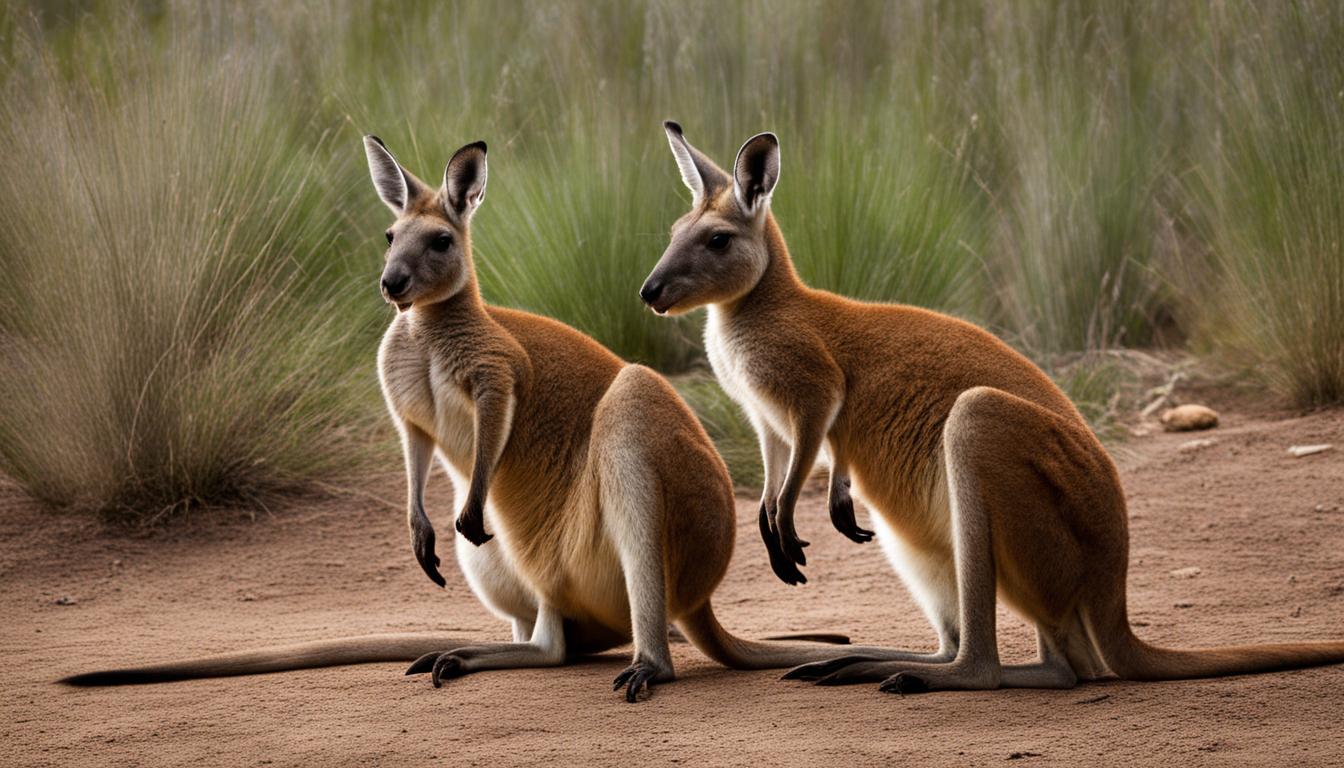When it comes to communication, kangaroos have a fascinating repertoire of sounds and methods. From vocalizations to body language, these unique creatures have developed various ways to convey messages and interact with others in their environment.
Let’s dive into the world of kangaroo communication and explore the different sounds, signals, and behaviors they use to express themselves.
Kangaroo Vocalizations: Conveying Messages Through Sound
Kangaroos have a diverse range of vocalizations that serve as a means of communication within their social groups. These vocal patterns, signals, and behaviors play a crucial role in conveying messages and maintaining social cohesion.
One of the most prominent vocalizations of kangaroos is their foot stomping, which is used to alert others of potential danger. This rhythmic thumping can be heard from a distance, serving as a warning signal and allowing other kangaroos to take appropriate action to ensure their safety.
In addition to foot stomping, kangaroos also use barking noises to communicate danger. These high-pitched vocalizations are often accompanied by vigorous movements, drawing the attention of others in the group and enabling swift response to potential threats.
| Kangaroo Vocal Patterns | Kangaroo Vocal Signals | Kangaroo Vocal Behavior |
|---|---|---|
| Coughing or grumbling sounds produced by male kangaroos to express submissiveness | Clucking or clicking noises used by female kangaroos to communicate with their joeys | Growling and screaming as a warning when feeling threatened or during aggressive altercations |
Male kangaroos, known as bucks, also utilize specific vocal behaviors to communicate submission and obedience. They produce coughing or grumbling sounds, which serve as signals to indicate their subordinate status within the group hierarchy. This vocal behavior helps maintain social harmony and reduce potential conflicts.
Furthermore, female kangaroos, known as does, use distinct clucking or clicking noises to communicate with their joeys. These vocalizations allow for mother-offspring bonding and provide important cues for the young kangaroos to follow their mothers’ guidance and stay close to them.
The vocal repertoire of kangaroos demonstrates their intricate communication system. By understanding the various vocalizations and their corresponding meanings, we gain insight into the complexity and dynamics of kangaroo social interactions.
Kangaroo Vocalizations: Conveying Messages Through Sound
Kangaroo Body Language: Understanding Non-Verbal Communication
While vocalizations play a significant role in kangaroo communication, their body language is equally important. Kangaroos utilize subtle movements of their ears, tails, and posture to convey emotions, intentions, and establish dominance within their groups.
Kangaroo Ear Movements: One key aspect of kangaroo body language is the movement of their ears. They have the ability to rotate their ears independently, allowing them to detect sounds from various directions. When a kangaroo is alert or curious, its ears are often upright, pointing forward. Conversely, flattened ears can indicate aggression or fear.
Kangaroo Tail Movements: The tail of a kangaroo is another expressive feature. A relaxed kangaroo tends to hold its tail outstretched behind it. However, a flicking or pounding tail may signal agitation or warning to others. When a kangaroo is preparing to fight, it may thump its tail on the ground as a display of dominance.
Kangaroo Posture: Kangaroos also communicate through their posture. When standing tall with an upright body and head held high, a kangaroo asserts its dominance. Conversely, a hunched or crouched position may indicate submission or a defensive stance. These postural cues help kangaroos navigate their social interactions and maintain the balance within their groups.
Table: Kangaroo Body Language Cues
| Cue | Meaning |
|---|---|
| Upright Ears | Alertness, curiosity |
| Flattened Ears | Aggression, fear |
| Outstretched Tail | Relaxation, contentment |
| Flicking or Pounding Tail | Agitation, warning |
| Hunched or Crouched Posture | Submission, defense |
Understanding kangaroo body language allows us to gain deeper insights into their behavior and interactions. It is a fascinating aspect of their communication system, complementing their vocalizations to create a complex and nuanced method of expression.

Kangaroo Courtship and Mating Rituals: Communicating for Reproduction
During the breeding season, kangaroos engage in courtship rituals to attract mates and secure successful mating opportunities. Communication plays a vital role in this process, with both males and females utilizing various vocalizations and physical displays.
Male kangaroos employ a range of vocal calls to showcase their prowess and reproductive fitness. These calls serve as mating signals and are often distinct to each species. For instance, the red kangaroo emits deep, resonating booms, while the eastern grey kangaroo produces soft clucking sounds.
In addition to vocalization, male kangaroos also employ physical displays to attract females. They perform impressive movements, such as boxing or wrestling with other males, to demonstrate their strength and dominance. These displays not only showcase their abilities but also communicate their fitness as a potential mate.
Mating Calls:
Female kangaroos are also active participants in courtship rituals, responding to the vocal and physical cues of the males. They communicate their receptiveness to mating through specific behaviors and vocalizations. For example, a female kangaroo may respond to a male’s courtship calls with submissive behaviors like lowering her head or lying on the ground.
Overall, courtship and mating rituals among kangaroos involve intricate communication patterns that are crucial for reproductive success. Through vocalizations and physical displays, kangaroos are able to convey their fitness and intentions, ensuring the continuation of their species.
Conclusion: Appreciating the Complexity of Kangaroo Communication
Throughout the animal kingdom, communication takes on various forms, each uniquely adapted to the needs of different species. Kangaroos, in particular, have developed a fascinating and intricate system of communication that involves both vocalizations and body language.
Every species of kangaroo showcases its own set of communication methods, highlighting the remarkable variations that exist within this diverse group. From the foot stomping and barking noises used to signal danger, to the clucking and clicking sounds employed by female kangaroos to communicate with their joeys, kangaroo communication is an intricate dance of signals and cues.
But communication among kangaroos extends beyond just vocalizations. Their body language plays a crucial role in conveying emotions, intentions, and hierarchical cues. Through subtle movements of their ears, tails, and posture, kangaroos navigate their social interactions and establish dominance within their groups.
Appreciating the complexity of kangaroo communication not only deepens our connection with the natural world, but also reminds us of the incredible diversity and adaptability of life on Earth. By observing and understanding the unique communication methods of kangaroos, we gain a greater appreciation for the rich tapestry of species that inhabit our planet.
What role do kangaroo sounds and communication methods play in their interactions with each other in the wild?
Kangaroo social behavior in the wild is largely based on communication through various sounds and body language. They make clicking noises to signal to each other, while females with joeys in their pouches will produce a soft clicking sound to communicate. Additionally, foot thumping is used as a warning signal.
FAQ
What sounds and communication methods do kangaroos use?
Kangaroos have various communication methods, including vocalizations and body language. They use foot stomping and barking noises to alert others of danger. Male kangaroos may produce grumbling sounds to express submissiveness. Female kangaroos communicate with their joeys through clucking or clicking noises. Additionally, kangaroos growl and scream when feeling threatened or during aggressive altercations.
How do kangaroos convey messages through sound?
Kangaroos communicate through vocalizations, using different patterns, signals, and behavior. They stomp their hind legs to alert others of danger and make high-pitched barking noises for the same purpose. Male kangaroos produce coughing or grumbling sounds to express obedience and submissiveness. Female kangaroos use clucking or clicking noises to communicate with their joeys. When feeling threatened, kangaroos growl and scream as a warning.
How do kangaroos communicate through body language?
In addition to vocalizations, kangaroos utilize body language for communication. They express their emotions, intentions, and hierarchical cues through subtle movements of their ears, tails, and posture. These non-verbal cues help them navigate their social interactions and establish dominance within their groups.
What role does communication play in kangaroo courtship and mating?
During the breeding season, male kangaroos engage in courtship rituals to attract females. They use vocal and physical displays, such as specific calls and movements, to showcase their prowess and reproductive fitness. Communication plays a crucial role in securing successful mating opportunities and ensuring the continuation of their species.
How do kangaroo communication methods vary among different species?
Kangaroo communication is a fascinating and intricate aspect of their lives. Each species of kangaroo has its unique communication system, showcasing interesting variations in vocalizations and body language. Understanding and appreciating their communication methods not only deepens our connection with the natural world but also highlights the complexity of the animal kingdom.










